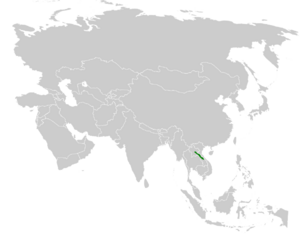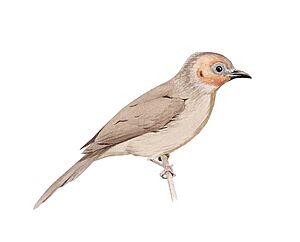Bare-faced bulbul facts for kids
Quick facts for kids Bare-faced bulbul |
|
|---|---|
 |
|
| Bare-faced bulbuls in Na Hin National Park, Laos | |
| Conservation status | |
| Scientific classification | |
 |
|
| Synonyms | |
|
The bare-faced bulbul (Nok hualon) is a unique type of bulbul. Bulbuls are a family of small passerine birds, often called songbirds. This special bird was first discovered in central Laos in 2009. It's one of the very few Asian songbirds that has a face without feathers. It was also the first new bulbul species found in Asia in almost 100 years!
Contents
What's in a Name? The Bare-faced Bulbul
The scientific name for this bird is Nok hualon. The word hualon comes from the Lao language. It means "bald-headed," which makes sense for a bird with a featherless face!
In 2018, scientists did a special study of bulbul families. They found that the bare-faced bulbul was quite different from other bulbuls. Because of this, they suggested putting it in its own new group, or genus. They named this new genus Nok, which simply means "bird" in Lao. So, its full scientific name became Nok hualon.
How to Spot a Bare-faced Bulbul
The bare-faced bulbul is mostly olive-green. Its most striking feature is its bare, pink face. It also has bluish skin around its eyes.
The birds that scientists have studied were about 20 centimeters (8 inches) long. They weighed between 32 and 40 grams (about 1 to 1.4 ounces). Their chest and belly are a light fawn-grey color. Their upper parts are olive, and their throat is off-white. If you hear one, researchers say its call sounds like a "dry bubbly tweet."
Where Do Bare-faced Bulbuls Live?
This bird is only known to live in a specific area of central Laos. This area is called a limestone karst region, near a place called Pha Lom. Karst regions are special landscapes with rocky hills made of limestone.
The bare-faced bulbul's home has steep rocky terrain. It also has short deciduous trees and shrubs, which are trees that lose their leaves. Scientists believe this bird might only live in this type of habitat. It's possible they live in other similar places in Laos too. This limestone karst habitat is also home to other unique animals found nowhere else, like the unusual Laotian rock rat.
Bare-faced Bulbul Behaviour
Bare-faced bulbuls mostly live in trees. However, you might also see them sitting on rocks on the steep hillsides. They are quite easy to spot!
These birds look for food during the day. They often search in pairs or sometimes alone. If a bird is alone, it tends to call out regularly. It will often join up with another bulbul before flying off to find food in a new spot. Scientists have not seen them join groups of different bird species looking for food together. We still don't know much about how these birds raise their young, as their breeding behavior has not been observed yet.
Protecting the Bare-faced Bulbul
In 2010, the bare-faced bulbul was evaluated by BirdLife International. It was listed as of Least Concern. This means that its population is not currently in danger. This decision was made because the species lives across a large area. Also, there wasn't enough information about how many birds there are or if their numbers were changing.
However, the limestone karst areas where these birds live are facing some threats. Things like quarrying (digging for rocks) and habitat degradation can harm their home. Overgrazing by animals can also damage their environment. More studies are needed to fully understand the bare-faced bulbul's population and ensure its future.



